 Russia is a land that is land itself … so vast … and yet its people have loved this land and preserved it so well.
Russia is a land that is land itself … so vast … and yet its people have loved this land and preserved it so well.  The Russians are also pioneers in every sense, reaching out and exploring because it’s in their very nature.
The Russians are also pioneers in every sense, reaching out and exploring because it’s in their very nature.  The Russian people are warm people who love to laugh and to share a good moment. Russians love good food and they love good company. They sip drinks and they tell good stories.
The Russian people are warm people who love to laugh and to share a good moment. Russians love good food and they love good company. They sip drinks and they tell good stories.
 ….there is one way to approach Russian fashion and that’s to look at modern trends and the shows in Moscow, etc. But there is also this vast lore of traditional fashion that goes back thousands of years.
….there is one way to approach Russian fashion and that’s to look at modern trends and the shows in Moscow, etc. But there is also this vast lore of traditional fashion that goes back thousands of years.
these fine classic apparels and the descriptions are from the excellent site RusClothing:
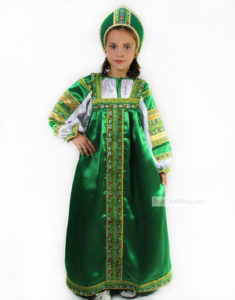 Traditional sarafan dresses are used for dance performances, ballets and theaters as well as on weddings and folk holidays occasions. The pattern and style of folk dresses, incl. Ukrainian costumes, keep old traditions and embroidery signs. Red, blue, green, white, yellow – folk costumes color range is rich and various.
Traditional sarafan dresses are used for dance performances, ballets and theaters as well as on weddings and folk holidays occasions. The pattern and style of folk dresses, incl. Ukrainian costumes, keep old traditions and embroidery signs. Red, blue, green, white, yellow – folk costumes color range is rich and various.
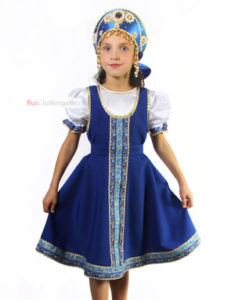 Originally Russian national costumes differed from one region to another, but there were two main Russian dress types: sarafan based and poneva based costumes. Most dance groups perform in sarafan dresses as they are more stylish and convenient to do folk dancing without restricting movement freedom.
Originally Russian national costumes differed from one region to another, but there were two main Russian dress types: sarafan based and poneva based costumes. Most dance groups perform in sarafan dresses as they are more stylish and convenient to do folk dancing without restricting movement freedom.
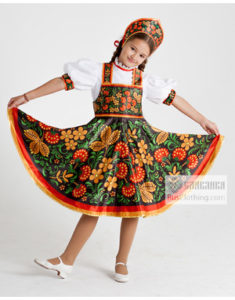 Old Russian traditional dresses identified people living in towns and villages, their income and origin. Festive clothes and everyday traditional clothing, married woman’s and young girl’s clothes differed by details, decoration, color range. Red fabric cloth was considered to be the choice one for sarafan dress. Russian word “beautiful” comes from the word “krasny”, the Russian for “red”.
Old Russian traditional dresses identified people living in towns and villages, their income and origin. Festive clothes and everyday traditional clothing, married woman’s and young girl’s clothes differed by details, decoration, color range. Red fabric cloth was considered to be the choice one for sarafan dress. Russian word “beautiful” comes from the word “krasny”, the Russian for “red”.
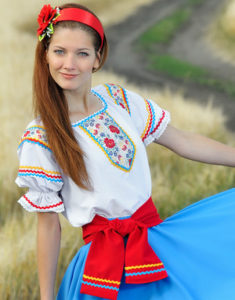 Kosovorotka, the Russian shirt, has a long history and keeps its style since old times. It is known for its straight-cut, elongated body and long sleeves. A matching belt adds final ethnic touch to the shirt.
Kosovorotka, the Russian shirt, has a long history and keeps its style since old times. It is known for its straight-cut, elongated body and long sleeves. A matching belt adds final ethnic touch to the shirt.
The Russian shirt can be worn also without a belt, with the collar buttoned or unbuttoned. Another name for the Russian shirt, tolstovka, comes from a famous Russian writer Leo Tolstoy who was always seen in a simple folk shirt at the end of his life. Some people even call it Tolstoy shirt. Tolstovka’s main difference from kosovorotka is in its simplicity, no extra embroidery.
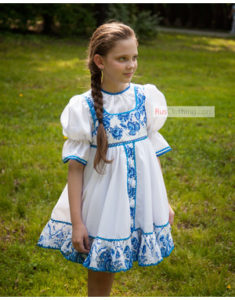 Fine embroidered ribbons decorate some Russian shirts on the chest and as a trim on sleeves and on the bottom of the shirt. Ukrainian shirts are usually embroidered by red or blue. Red was a symbol of beauty and protection colour at the same time.
Fine embroidered ribbons decorate some Russian shirts on the chest and as a trim on sleeves and on the bottom of the shirt. Ukrainian shirts are usually embroidered by red or blue. Red was a symbol of beauty and protection colour at the same time.
 Russian tiaras are known by word kokoshnik. Today the headdress Kokoshnik is a part of Russian traditional costume. Kokoshniks presented in our shop are handmade and skillfully decorated in Russia. Russian headdresses are usually bought together with traditional dresses or costumes and used for dance performances and theaters.
Russian tiaras are known by word kokoshnik. Today the headdress Kokoshnik is a part of Russian traditional costume. Kokoshniks presented in our shop are handmade and skillfully decorated in Russia. Russian headdresses are usually bought together with traditional dresses or costumes and used for dance performances and theaters.
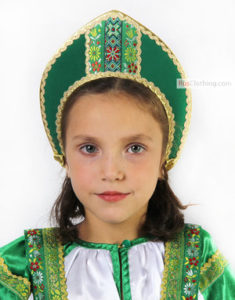 Russian tiaras were a popular head decorative element in Russia in XVIII century. Kokoshniks have a great variety of headwear versions and styles across Russia. The best known kokoshnik has a high front shaped like a crescent with rounded edges. The front of a kokoshnik is decorated with golden thread and pearls embroidery. Kokoshniks and kichka, though varied in shape, were a subject to the strictest regulations: no married woman could show her hair in public. Maidens, on the other hand, were expected to have at least tops of their heads uncovered, and were free to show off the beauty of their hair.
Russian tiaras were a popular head decorative element in Russia in XVIII century. Kokoshniks have a great variety of headwear versions and styles across Russia. The best known kokoshnik has a high front shaped like a crescent with rounded edges. The front of a kokoshnik is decorated with golden thread and pearls embroidery. Kokoshniks and kichka, though varied in shape, were a subject to the strictest regulations: no married woman could show her hair in public. Maidens, on the other hand, were expected to have at least tops of their heads uncovered, and were free to show off the beauty of their hair.
 The Russian blouse was historically a part of the traditional women clothing together with a sarafan. Today the folk blouse is a stylish outfit. Folk motifs of Russian blouses are always in trend with fashion ideas. Traditional Ukrainian blouses look great with jeans or a skirt! Decorated with ethnic themes, folk and casual Russian blouses features a wide variety of traditional models and embroidered ornaments. The fabric used for is 100% fine cotton or Russian linen decorated with symmetric stylized pattern or embroidery. Soft silhouette without any cuts emphasizes lady’s elegance. Ukrainian blouses in different sizes and colors are perfect for any occasion.
The Russian blouse was historically a part of the traditional women clothing together with a sarafan. Today the folk blouse is a stylish outfit. Folk motifs of Russian blouses are always in trend with fashion ideas. Traditional Ukrainian blouses look great with jeans or a skirt! Decorated with ethnic themes, folk and casual Russian blouses features a wide variety of traditional models and embroidered ornaments. The fabric used for is 100% fine cotton or Russian linen decorated with symmetric stylized pattern or embroidery. Soft silhouette without any cuts emphasizes lady’s elegance. Ukrainian blouses in different sizes and colors are perfect for any occasion.
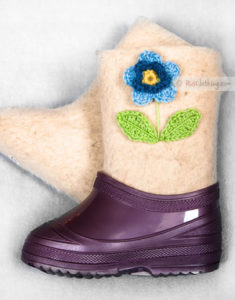 Footwear designed in Russian traditions is mainly valenki which are often called by Russian felt boots or winter boots. Valenki, popular long time ago, catch second wind today. Russian felt boots, stylish and warm are perfect for any snowy winter. Valenki are highly appreciated in the USA, Great Britain and other countries.
Footwear designed in Russian traditions is mainly valenki which are often called by Russian felt boots or winter boots. Valenki, popular long time ago, catch second wind today. Russian felt boots, stylish and warm are perfect for any snowy winter. Valenki are highly appreciated in the USA, Great Britain and other countries.
” … We give praise and thanks that the Simple Key to Perfect Happiness may be given to bless …”